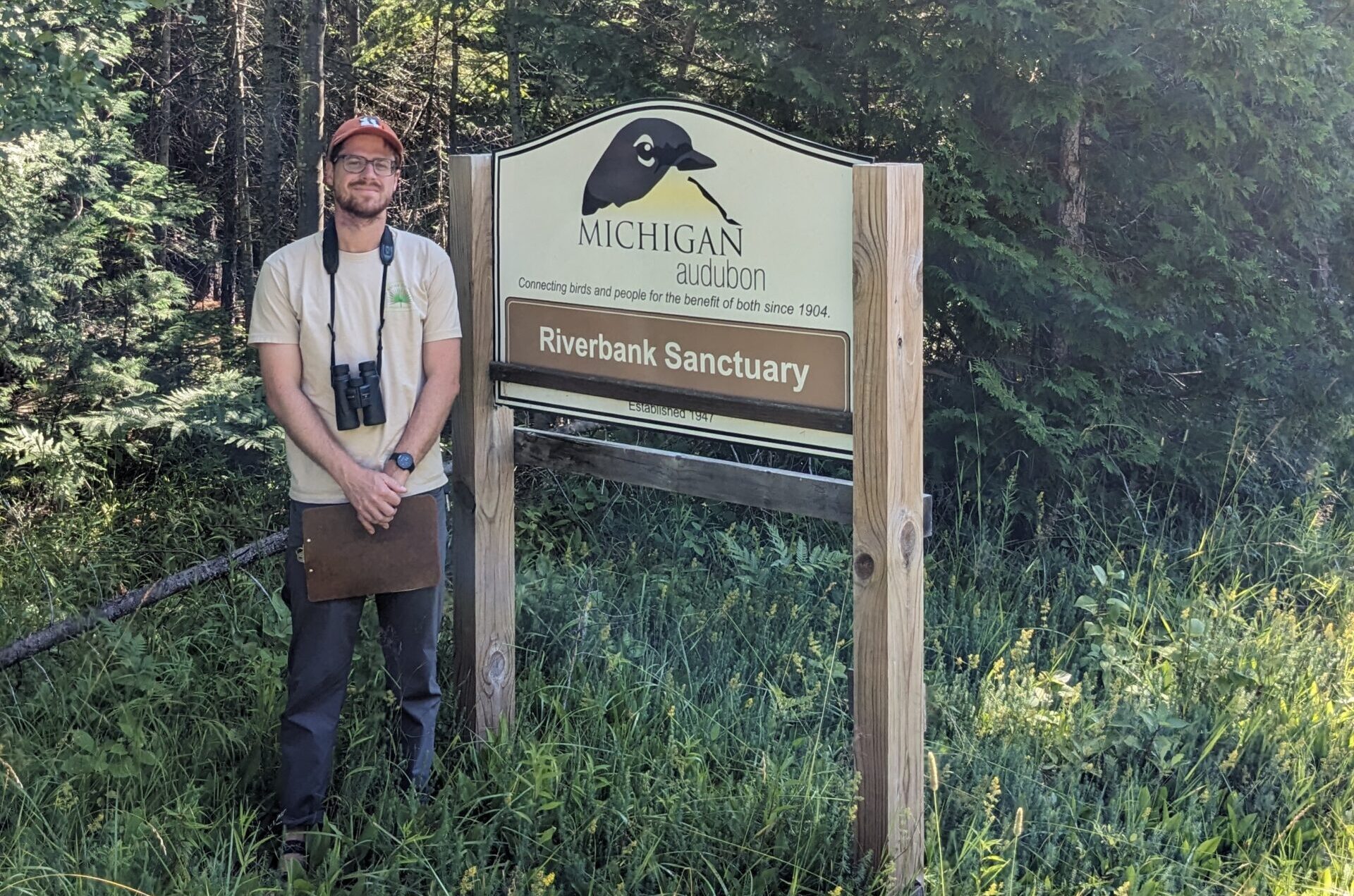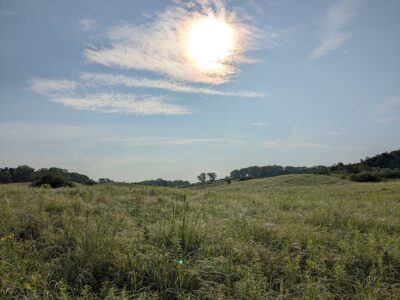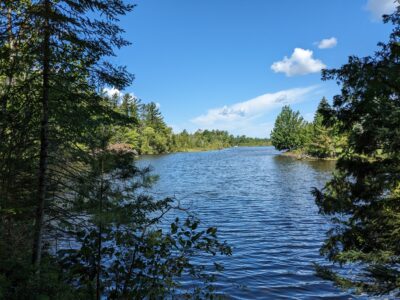Five months have passed since I started as the conservation manager with Michigan Audubon, and I made the most of my time by setting out to visit as many sanctuaries as made sense this first season. I focused on the sanctuaries nearest our home base of Okemos but also made it up to the U.P. to see properties such as Little Lake Sanctuary in Chippewa County and Riverbank Bird Sanctuary in Manistique.
Visiting these sites is, in my opinion, the best way to understand them. I need to spend time on the land, to bird, to touch the plants, to get my feet wet, and to speak with the volunteers who’ve dedicated hour upon hour to improving them — I need to know the sanctuaries like the back of my hand. This enables me to know, for example, of that secret patch of invasive spotted knapweed on top of a hill at Otis Farm Bird Sanctuary, a patch that can’t be seen from the trail, that could easily go unnoticed and begin to dominate the sandy, barren hilltop, outcompeting the native plants we aim to support. It also allows me to speculate on the provenance of things. When considering the spotted knapweed, I ask myself, “How did it get to this spot? It’s near the bluebird boxes. Was it brought in while nests were being checked? If so, is it near other boxes, too? How can we prevent this?”
As much as I love to be onsite, high-stepping through the tall grass or trekking through a bog, the files in my cabinets provide essential information as well. The historical details of acquisition and management are indispensable and inform me why a sanctuary is the way it is now. Historical photos and descriptions of sites also give inspiration to restoration efforts. In the October 1941 issue of the Jack Pine Warbler, Lawrence Walkinshaw wrote about the birds that have been seen in and around the area of our Bernard W. Baker Sanctuary. He felt sure that Red-headed Woodpeckers were breeding in the area and recorded their first observation there on March 26, 1933. While not wholly absent at Baker currently, it was in November 2021 that they were last recorded there in eBird. I’d like to see them as consistent breeders on the property, which means working towards developing a more open, oak-savanna habitat with abundant snags for nesting and ensuring that breeding bird surveys are being done around the property to note their presence. Other birds that Walkinshaw notes offer glimpses of a past that will never be seen again, such as Passenger Pigeons seen in the area by his grandfather in the 1870s. No amount of restoration will bring these birds back to Baker.
To help you stay connected as I continue to explore these beautiful properties, we’ll be presenting regular updates about activities going on at them: birds seen or heard, conservation work, improvements, interesting plants, and more. Please follow along to see how our sanctuaries change through the seasons and over the years.
CONSERVATION HIGHLIGHTS
July 28 – August 11, 2023
At the end of July, I drove to Whitefish Point Bird Observatory to participate in a spotted knapweed pull. This non-native invasive plant is pretty common downstate and can completely dominate communities of dry, sandy soil with low nutrients. My partner and I met with Michael Hindy of the Three Shores CISMA, along with two other CISMA folk, a few individual volunteers, and the Sault Tribe Americorps team to pull. We fanned the beach pulling all in our path, and then, after lunch, we headed into the jack pines to pull more. There were definitely dense pockets of spotted knapweed, but overall the population is not out of control.
The following day, we met with Blake Sexton of the Little Traverse Conservancy (LTC) to check out Little Lake Sanctuary, a landlocked property with no public access, upon which LTC has a conservation easement. We ventured through knee to chest-high leatherleaf and sweet gale bog until we got to a somewhat dried conifer swamp, followed by going to the upland areas and then back down to herbaceous areas of the bog. This was a fun but wet and tiring trip! The floating bog mat next to Little Lake is filled with lovely bog species such as pitcher plant and sundew. We stumbled across a ground nest from this year, either a Hermit Thrush or a Veery. Birds noted at Little Lake include Swamp Sparrow, Common Yellowthroat, American Redstart, and Common Raven.
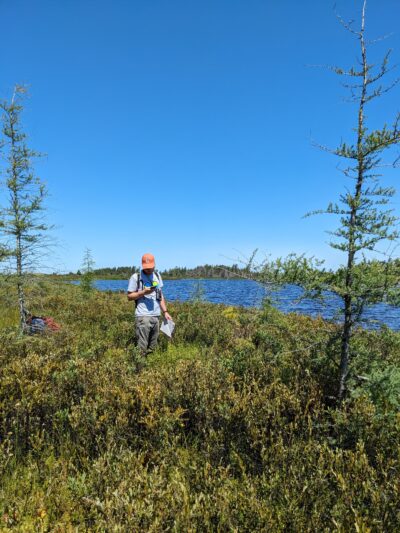
Conservation Manager Chad Machinski and Blake Sexton of Little Traverse Conservancy identifying plants on the bog mat at Little Lake Sanctuary. Photo by Murphy Harrington
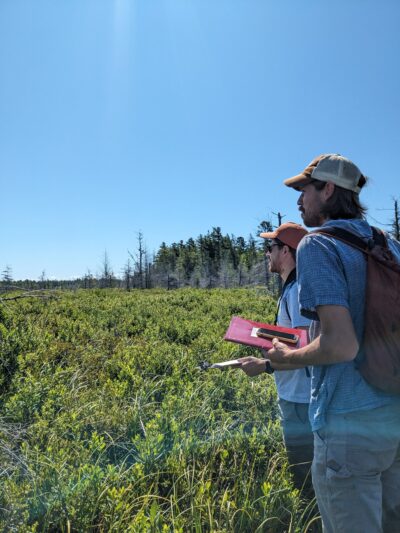
Conservation Manager Chad Machinski and Blake Sexton of Little Traverse Conservancy look out at the bog. Photo by Murphy Harrington
On the way back home the next day, we took a detour to Manistique to visit the small Riverbank Sanctuary, which sits along the Indian River and has a short trail. I GPS’ed the trail and then proceeded to meander around, taking notes on plants. The property seems to get some use but has many trees down on the trail, which the Schoolcraft County Conservation District has offered to help with. I added approximately 40 species to the plant list, including plants along the road that are disturbance-loving non-natives. Birds noted include Red-breasted Nuthatch, Black-capped Chickadee, Red-eyed Vireo, and Mallard.
On August 8 and 9, I spent time at Otis Farm Bird Sanctuary and Ronald H. Warner Sanctuary in Hastings. Upon arriving at Otis, I was saddened to see that the Tree Swallows that were so common in the upland prairie had all moved on. They’ve been a constant there since the spring, and I was not even considering the fact that they would move on from the property. I set out to begin removing Tatarian honeysuckle and autumn olive from one of the first areas seen when getting on the trail into the prairie. These shrubs can completely alter the natural community we are trying to establish at this site, one that gets burned occasionally and could be habitat for Henslow’s Sparrows, a species documented there in the past, and other grassland birds. That evening, I was joined by the Klein and Bachert families, who are volunteers, skilled birders, and moth-ers. Yes, “moth-ers.” The objective that evening was to set up a couple of sheets and lights to attract and document moth species on the property. We recorded approximately 35 moth species, saw bats emerge from the Otis barn, and heard a Whip-poor-will and Great Horned Owl. A fun night! I then spent half the following day at Warner, just five minutes up the road, removing the autumn olive encroaching on the beautiful mesic forest on the east side of Glass Creek. The remainder of the day was spent at Otis, keeping trails and the boardwalk trimmed back so visitors can walk unimpeded.
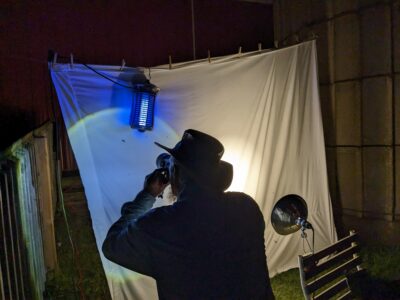
Otis, 8/08/2023. Moth Night. Volunteer Del Bachert takes photos of moths. Photo by Chad Machinski

Volunteer Anne Klein takes photo of a moth with phone. Photo by Del Bachert
August 10 saw a return to Capital City Bird Sanctuary (CCBS) in Lansing. I met up with my reliable team of volunteers to tackle a clump of autumn olive that has been laughing at me since I started in March. We swiftly cut through this stand and moved down the trail to nix any more we came across. This work will continue through the year and will likely need follow-up next year. With the volunteers we have at CCBS, I’m confident that we can work to eliminate this plant from the property.
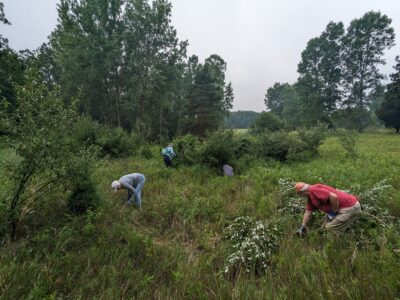
CCBS volunteers removing autumn olive. Photo by Chad Machinski
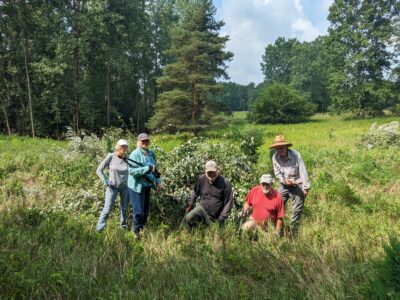
CCBS volunteers. Photo by Chad Machinski
The end of my week-long tour saw me meeting with Haehnle Committee Chair Steve Jerant, former chair Gary Siegrist, and representatives from U.S. Fish & Wildlife Service (USFWS) at our Phyllis Haehnle Memorial Sanctuary in Grass Lake. We discussed future work in the marsh, prairies, and savannas that USFWS could help with. This is a great partnership that I’m excited to continue with. After our meeting, Steve and I pulled hedge parsley, a non-native invasive plant in the carrot family that was abundant at the entrance and infrequent along the sanctuary’s trails. Just as the rain rolled in that day, Steve and I planted a flat of tower mustard, a native mustard found in sandy soils.
The remainder of August will see visits to Haehnle, CCBS, and Baker. Stay tuned!
To learn more about Michigan Audubon sanctuaries, visit michiganaudubon.org/our-conservation-impact/bird-sanctuaries. If you want to volunteer at a Michigan Audubon sanctuary, please complete the Sanctuary Volunteer Interest Form.
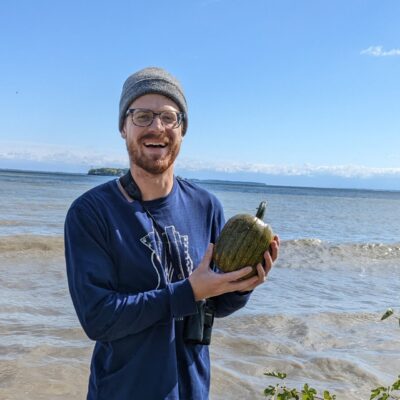
Chad Machinski, MS
Conservation Manager
While Chad’s first love is botany, he doesn’t deny the intertwining nature of birds, plants, insects, and all other organisms we share the world with. His passion for the natural world began in his undergraduate time at the University of Michigan, taking several different forms along the way. His graduate studies at the University of Michigan allowed him to more closely examine the natural communities of Michigan and further understand the complex nature of ecosystems. His work as a Nichols Arboretum Caretaker while in school further enabled him to be directly involved in conservation work as he led workdays removing invasive plant species, performed trail maintenance, and guided tours. Chad can usually be found out in a park in a few ways: binoculars glued to his face, hunched over looking at plants, or flipping logs looking for snakes and salamanders.

